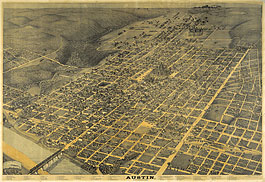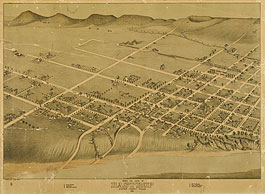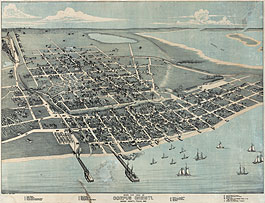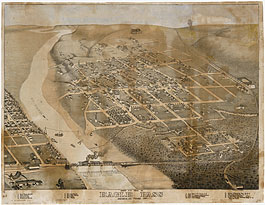Austin in 1887
Koch paid a return visit to Austin in 1887. The city was much larger by then—in the ensuing fourteen years, the population almost doubled to well over 11,000—and Koch reflected that in a print even larger than the one he had made of San Antonio. The eye easily traces the new growth in a diagonal line from lower left to upper right: from the reconstructed bridge over the Colorado… [More]
Bastrop in 1887
During what might have been his fourth tour of Texas, Augustus Koch paused to sketch a bird’s-eye view of Bastrop, a small city of approximately 2,000 persons about thirty miles southeast of Austin. The city is located on the east bank of the Colorado River on a bluff that is generally level until it rises gently to form the low hills east of town, home to the remnants of… [More]
Corpus Christi in 1887
Although various Indian bands had inhabited the area at the mouth of the Nueces River for centuries, the Spaniards never successfully settled Corpus Christi. Anglo merchants established a trading post there in 1839, following the war between the United States and Mexico, but it did not prosper until the decade of the 1870s, when sheep and cattle ranching became widespread in South Texas, with Corpus Christi as the primary… [More]
Eagle Pass in 1887
Augustus Koch’s bird’s-eye view of Eagle Pass is dominated by the Rio Grande on the left side of the picture; the Galveston, Harrisburg and San Antonio Railway at the right and bottom; and Fort Duncan in the lower right-hand corner. An unnamed creek separates the city from the fort.
Eagle Pass began in 1850 when a settlement grew up around Fort Duncan, which had been established the previous year on… [More]













